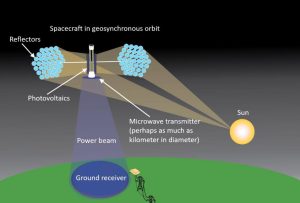The Focus of New Attention — Gravel2Gavel Construction & Real Estate Law Blog — June 14, 2023
Scientists have long proposed that solar electricity generation in space could be an integral component of the world’s carbon-free future. In the 1970s, a U.S. Navy experiment showed that it might be possible to capture solar power and wirelessly transmit it from outer space using microwave beams. Progress stalled after that early test—the models used were at such a massive scale that creating a real-world system felt like science fiction. Recently, amid growing concerns about power grid security and intensifying legislation around carbon emissions, renewed attention focused on a smaller, more lithe microwave transmission system. This time around, the military is not the only interested party. Scientists around the world are conducting similar research. As investors and governments stand at the edge of a fresh green power opportunity, we look at microwave power transmission and some of the projects in this emerging field.
The basic premise of space-based solar power technology is simple enough: photovoltaic panels on a satellite in space convert the sun’s energy to electromagnetic waves at microwave frequencies. The satellite then beams the microwave energy to a receiver on Earth that transforms it into direct current. Until recently, this technique had been performed on the ground over short distances, but nobody had attempted to launch a solar panel into space. The status quo has shifted over the past few years as researchers have begun to send prototypes into orbit. In early 2023, CalTech was the first to report a breakthrough. Its model successfully beamed power from space back to their receiver atop a building in California.
Space-based solar enjoys theoretical advantages over collecting power on the ground, where panels are at the mercy of nightfall, clouds and unpredictable weather patterns. If correctly positioned, interstellar solar panels can access the sun’s rays nearly continuously, harnessing as much as twice the power that an equivalent panel can convert on Earth.
Another obvious perk of space-based electricity generation is that transmission does not require all the wires (and rights of way) that connect existing power grids. Electromagnetic beams are also less susceptible to environmental influences: even in heavy rain, the beam would reportedly lose no more than 5% of its functionality. In spite of the carbon emissions inherent in launching a large number of solar panels into space, the overall carbon footprint would likely still be much smaller than terrestrial solar power. By using multiple microwave transmitters and controlling their phases, the beam could be directed to multiple places on the Earth’s surface, potentially supporting pinpoint delivery of power at otherwise hard to access locations.
A large perception-based challenge for this technology, aside from the logistical gymnastics of building complex pieces of equipment beyond Earth’s atmosphere, is the potential safety risk surrounding microwaves. The waves used in the U.S. Navy’s latest testing are much weaker than those of a microwave oven. Additionally, some of the technology is designed to pause if it encounters an obstacle (such as a bird). Still, it might take time to convince would-be energy users that power beamed down from space meets safety concerns.
Scientists are still brainstorming the best approaches to building this technology. To produce power comparable to that of a traditional midsized power plant, a stationary solar panel satellite would be much heavier than any typical satellite and would require a land-bound receiver that is about a mile in diameter. Researchers are workshopping the scale issue by looking at ways to weave together a series of smaller components over time that could orbit closer to Earth and beam down to more compact receivers. (Another question is whether repair of these satellites would be possible as they hover deep in space.)
The following projects are working to make microwave-transmitted solar power a reality, with promising results—and varying goals:
- MAPLE. In January 2023, CalTech’s Space Solar Power Project sent a solar power prototype into orbit. The team behind the project says that it has successfully transmitted energy from one receiver to another in outer space, and, in a landmark for the field, it also beamed energy back to Earth. The prototype, Microwave Array for Power-transfer Low-orbit Experiment (MAPLE), consists of an array of microwave power transmitters driven by affordable electronic silicon chips. The transmitters can stream collected solar energy to desired locations, and they are designed to be lightweight and flexible, allowing them to minimize the footprint (and fuel) needed to transport them into space. Funded by a philanthropist and his wife, this project’s aim is to democratize power. The systems being developed would ideally be low-cost and enable power to reach even remote locations without the need for large energy infrastructure on the ground.
- SCOPE-M. In another step forward, the U.S. Naval Research Laboratory beamed power at two separate locations (the U.S. Army Research Field in Maryland and the Haystack Ultrawideband Satellite Imaging Radar transmitter at MIT) during its 2022 SCOPE-M tests. Though this demonstration was down on land rather than in space, the success highlighted that a low and safe frequency could be quite effective at broadcasting microwave power. The team shot 1.6 kilowatts of power from a microwave dish to a receiver .6 miles away. The U.S. Navy, which says this is their “most significant power beaming demonstration in nearly 50 years,” is interested in the technology because for troops in the field or on the water, it could mitigate a reliance on physical fuel supplies.
- Emrod. Based in New Zealand, this private tech company announced last October that inside a Munich Airbus facility, it had beamed power wirelessly from a transmitter to a receiver that was 118 feet away. The company’s initial commercial focus is on powering remote renewable sites and communities, as well as large vehicles, and aiding in disaster recovery, among other goals. It anticipates offering systems for sale within three to four years that would wirelessly transfer electricity on the ground. In the long-term, the company says that space-based solar power is on the horizon in a decade or so.
- Northrop Grumman. For years, private company Northrop Grumman has built weather-monitoring tools, including most recently the Advanced Technology Joint Polar Satellite System-2 spacecraft (ATMS), which helps forecasters access atmospheric temperature and moisture data by detecting microwave radiation from the Earth. In 2018, the U.S. Air Force Research Laboratory (AFRL) gave the company a $100 million contract to develop a prototype that could demonstrate key components of a space solar power system. The laboratory wants to provide solar power to remote military bases. In December 2022, Northrop Grumman said it had completed ground-based testing and is ready to build and integrate hardware in preparation for a 2025 launch as part of the AFRL Space Solar Power Incremental Demonstrations and Research Project (SSPIDR) program.
- Space Energy Initiative. As part of the UK’s Net Zero policy, which aims for zero carbon emissions by 2050, the Space Energy Initiative (SEI) is heading up efforts in the UK for large scale space-based solar power. The initiative hopes to pool resources across the government, research, energy and space sectors, while also partnering with other countries, to deliver an operational solar power system by 2040. The organization’s satellite design concept features solar collectors that always point at the sun and that accommodate an elliptical orbit, which can come closer to the Earth than a circular one. The SEI aims to cut reliance on fossil fuels.
- Solaris. The European Space Agency’s Solaris program is researching the feasibility and costs of beaming solar power to Earth, calling for an in-orbit demonstration to be launched in 2030. The initiative would then launch a small version of a space solar plant in the mid-2030s with the intention of scaling it up significantly. It hopes to carve out a place for Europe as an international leader in carbon cutting solutions.
Many more projects are underway around the globe, including in Russia and China, as nations look to keep up with the fast pace of climate legislation. Martin Soltau, co-chair at the SEI, told the BBC that solar energy from space “could supply all of the world’s energy in 2050.”
Amid the thrill of high-tech, space-powered energy, the question remains of how realistic these endeavors are. The 1970s-era technology that was available when the U.S. military first explored wireless solar power would have cost $1 trillion to execute. But today, a boost in the space materials supply chain means prices are dropping. Spacecraft can increasingly be built with mass-produced, modular components. Paired with the recent success of private space operators and their ability to affordably carry heavy materials into orbit, researchers and developers are optimistic about the feasibility of creating a viable space-based energy source. Space-driven solar power channeled through microwave beams may sound far-fetched, but the emerging technology could prove to be a key force in taking on clean energy initiatives around the world.






